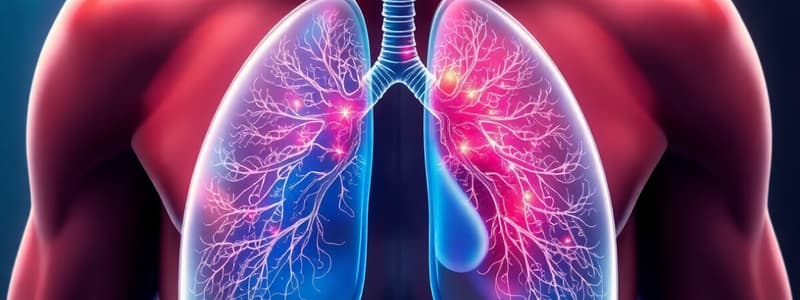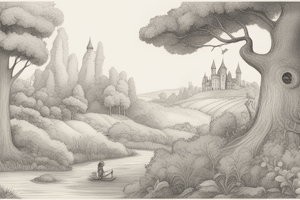Podcast
Questions and Answers
Which of the following is NOT a key feature of an effective respiratory surface for gas exchange?
Which of the following is NOT a key feature of an effective respiratory surface for gas exchange?
- A short diffusion distance for gases to pass through.
- A rich blood supply to the respiratory surface to maintain a steep concentration gradient, speeding up the rate of gas diffusion and exchange.
- A large surface area for gas exchange.
- A dry surface to allow gases to dissolve and diffuse readily. (correct)
- A permeable surface for the passage of respiratory gases.
The human lung is divided into two lobes, one on the left and one on the right.
The human lung is divided into two lobes, one on the left and one on the right.
False (B)
What is the name of the tiny air sacs in the lungs where gas exchange occurs?
What is the name of the tiny air sacs in the lungs where gas exchange occurs?
alveoli
The ______ is the windpipe that carries air from the nose and mouth to the lungs.
The ______ is the windpipe that carries air from the nose and mouth to the lungs.
Match the following lung structures with their descriptions:
Match the following lung structures with their descriptions:
Flowering plants have a specialized system for oxygen transport similar to humans.
Flowering plants have a specialized system for oxygen transport similar to humans.
Which of the following structures is responsible for warming the inhaled air?
Which of the following structures is responsible for warming the inhaled air?
Which of the following is NOT a reason why flowering plants can survive without a specialized oxygen transport system?
Which of the following is NOT a reason why flowering plants can survive without a specialized oxygen transport system?
Why do organisms with flattened bodies have an advantage in gas exchange?
Why do organisms with flattened bodies have an advantage in gas exchange?
C-shaped cartilage is present in the bronchi to prevent its collapse during exhalation.
C-shaped cartilage is present in the bronchi to prevent its collapse during exhalation.
A ______ mechanism moves fresh air over the respiratory surface in large organisms.
A ______ mechanism moves fresh air over the respiratory surface in large organisms.
What are the two main functions of mucus in the respiratory system?
What are the two main functions of mucus in the respiratory system?
Match the following adaptive features with their corresponding function:
Match the following adaptive features with their corresponding function:
The ______ membrane forms an airtight space around the lungs, reducing friction during breathing.
The ______ membrane forms an airtight space around the lungs, reducing friction during breathing.
Match the following structures with their respective functions:
Match the following structures with their respective functions:
Which blood vessel, A or B, has a higher concentration of oxygen?
Which blood vessel, A or B, has a higher concentration of oxygen?
Which of the following structures is responsible for warming incoming air in the respiratory system?
Which of the following structures is responsible for warming incoming air in the respiratory system?
The epiglottis is a flap of cartilage that prevents food from entering the trachea during swallowing.
The epiglottis is a flap of cartilage that prevents food from entering the trachea during swallowing.
The dust deposit in the lung tissue increases the surface area available for gas exchange.
The dust deposit in the lung tissue increases the surface area available for gas exchange.
What effect does the dust deposit have on the diffusion distance of oxygen?
What effect does the dust deposit have on the diffusion distance of oxygen?
What two types of cells are present in the nasal cavity and what are their functions?
What two types of cells are present in the nasal cavity and what are their functions?
The ______ is the opening at the larynx.
The ______ is the opening at the larynx.
The dust deposit causes a ______ in lung elasticity.
The dust deposit causes a ______ in lung elasticity.
Match the effects of the lung disease on gas exchange with their corresponding explanations:
Match the effects of the lung disease on gas exchange with their corresponding explanations:
Match the following structures with their primary functions:
Match the following structures with their primary functions:
During inhalation, what happens to the diaphragm?
During inhalation, what happens to the diaphragm?
Exhalation is a passive process that requires no muscle action.
Exhalation is a passive process that requires no muscle action.
What is the primary force that drives air into the lungs during inhalation?
What is the primary force that drives air into the lungs during inhalation?
Which of the following is NOT a characteristic of the trachea?
Which of the following is NOT a characteristic of the trachea?
The ______ muscles help to control the movement of the rib cage during ventilation.
The ______ muscles help to control the movement of the rib cage during ventilation.
Bronchioles are supported by circular rings of cartilage.
Bronchioles are supported by circular rings of cartilage.
What is the primary function of the cilia in the trachea?
What is the primary function of the cilia in the trachea?
Match each process to its effect on thoracic cavity volume:
Match each process to its effect on thoracic cavity volume:
The ______ is the site where gas exchange takes place in the lungs.
The ______ is the site where gas exchange takes place in the lungs.
Match the following structures of the respiratory system with their primary function:
Match the following structures of the respiratory system with their primary function:
What is the primary function of the pleural fluid?
What is the primary function of the pleural fluid?
The lungs are protected by the rib cage.
The lungs are protected by the rib cage.
What happens to the lung if the pleural membrane is punctured?
What happens to the lung if the pleural membrane is punctured?
The space between the outer and inner pleural membrane is called the ______.
The space between the outer and inner pleural membrane is called the ______.
Match the following components with their descriptions:
Match the following components with their descriptions:
What happens to the left lung if the pleural membrane on the left side of the thorax is punctured?
What happens to the left lung if the pleural membrane on the left side of the thorax is punctured?
A smoker is less likely to be short of breath than a non-smoker during vigorous exercise.
A smoker is less likely to be short of breath than a non-smoker during vigorous exercise.
What structural difference is observed in the lung tissue of a smoker compared to a non-smoker?
What structural difference is observed in the lung tissue of a smoker compared to a non-smoker?
The reduced surface area for gas exchange in smokers leads to a lower rate of _______ diffusion to the blood.
The reduced surface area for gas exchange in smokers leads to a lower rate of _______ diffusion to the blood.
Match the following lung conditions with their outcomes:
Match the following lung conditions with their outcomes:
Flashcards
Gas Exchange
Gas Exchange
Transfer of oxygen to blood and CO2 to exhaled air.
Effective Respiratory Surface
Effective Respiratory Surface
Features include large area, moist, thin, and rich blood supply.
Large Surface Area
Large Surface Area
An essential feature to maximize gas exchange efficiency.
Short Diffusion Distance
Short Diffusion Distance
Signup and view all the flashcards
Rich Blood Supply
Rich Blood Supply
Signup and view all the flashcards
Path of Air Flow
Path of Air Flow
Signup and view all the flashcards
Nasal Cavity Functions
Nasal Cavity Functions
Signup and view all the flashcards
Trachea Structure
Trachea Structure
Signup and view all the flashcards
Pleural Membrane
Pleural Membrane
Signup and view all the flashcards
Diaphragm's Role
Diaphragm's Role
Signup and view all the flashcards
Vessel A vs Vessel B Oxygen
Vessel A vs Vessel B Oxygen
Signup and view all the flashcards
Glucose Levels in Vessels
Glucose Levels in Vessels
Signup and view all the flashcards
Increased Diffusion Distance
Increased Diffusion Distance
Signup and view all the flashcards
Reduced Diffusion Area
Reduced Diffusion Area
Signup and view all the flashcards
Reduced Lung Elasticity
Reduced Lung Elasticity
Signup and view all the flashcards
Nostrils
Nostrils
Signup and view all the flashcards
Nasal Cavity
Nasal Cavity
Signup and view all the flashcards
Pharynx
Pharynx
Signup and view all the flashcards
Larynx
Larynx
Signup and view all the flashcards
Epiglottis
Epiglottis
Signup and view all the flashcards
Gas Exchange in Flowering Plants
Gas Exchange in Flowering Plants
Signup and view all the flashcards
Photosynthesis and Oxygen Production
Photosynthesis and Oxygen Production
Signup and view all the flashcards
Stomata
Stomata
Signup and view all the flashcards
Diffusion in Plants
Diffusion in Plants
Signup and view all the flashcards
Gas Exchange in Small Organisms
Gas Exchange in Small Organisms
Signup and view all the flashcards
Challenges for Large Organisms
Challenges for Large Organisms
Signup and view all the flashcards
Human Heart Function
Human Heart Function
Signup and view all the flashcards
Role of Blood Vessels
Role of Blood Vessels
Signup and view all the flashcards
Pleural Membrane Puncture
Pleural Membrane Puncture
Signup and view all the flashcards
Breathing Changes After Collapse
Breathing Changes After Collapse
Signup and view all the flashcards
Air Flow Comparison
Air Flow Comparison
Signup and view all the flashcards
Smoker vs Non-Smoker Lungs
Smoker vs Non-Smoker Lungs
Signup and view all the flashcards
Shortness of Breath in Smokers
Shortness of Breath in Smokers
Signup and view all the flashcards
Inhalation
Inhalation
Signup and view all the flashcards
Intercostal Muscles
Intercostal Muscles
Signup and view all the flashcards
Diaphragm
Diaphragm
Signup and view all the flashcards
Exhalation
Exhalation
Signup and view all the flashcards
Thoracic Cavity
Thoracic Cavity
Signup and view all the flashcards
Lungs
Lungs
Signup and view all the flashcards
Rib cage
Rib cage
Signup and view all the flashcards
Pleural cavity
Pleural cavity
Signup and view all the flashcards
Pleural fluid
Pleural fluid
Signup and view all the flashcards
Trachea
Trachea
Signup and view all the flashcards
Ciliated epithelial cells
Ciliated epithelial cells
Signup and view all the flashcards
Mucus-secreting cells
Mucus-secreting cells
Signup and view all the flashcards
Bronchi
Bronchi
Signup and view all the flashcards
Bronchioles
Bronchioles
Signup and view all the flashcards
Air Sac
Air Sac
Signup and view all the flashcards
C-shaped cartilages
C-shaped cartilages
Signup and view all the flashcards
Nose breathing
Nose breathing
Signup and view all the flashcards





